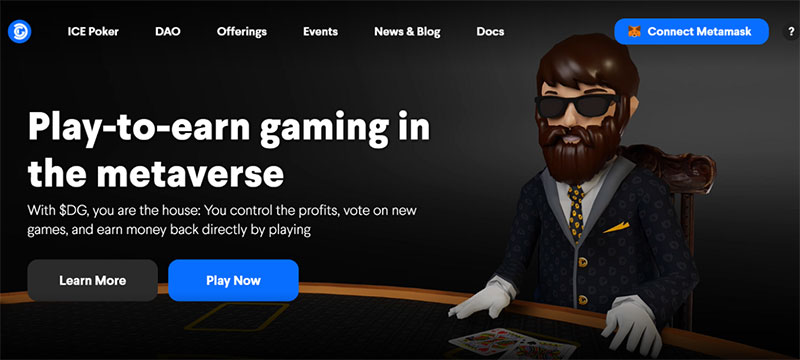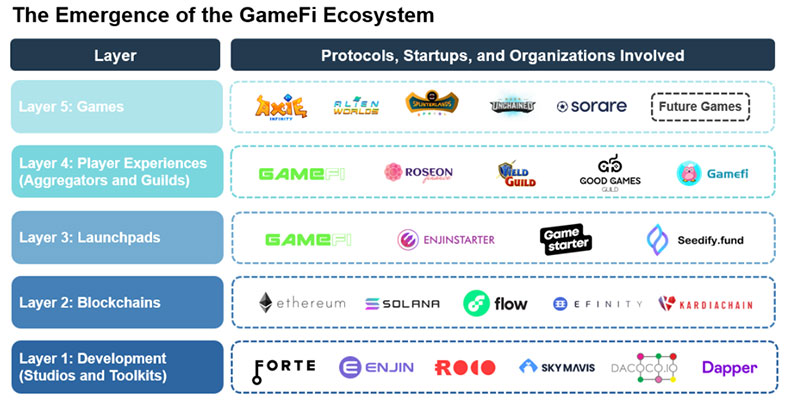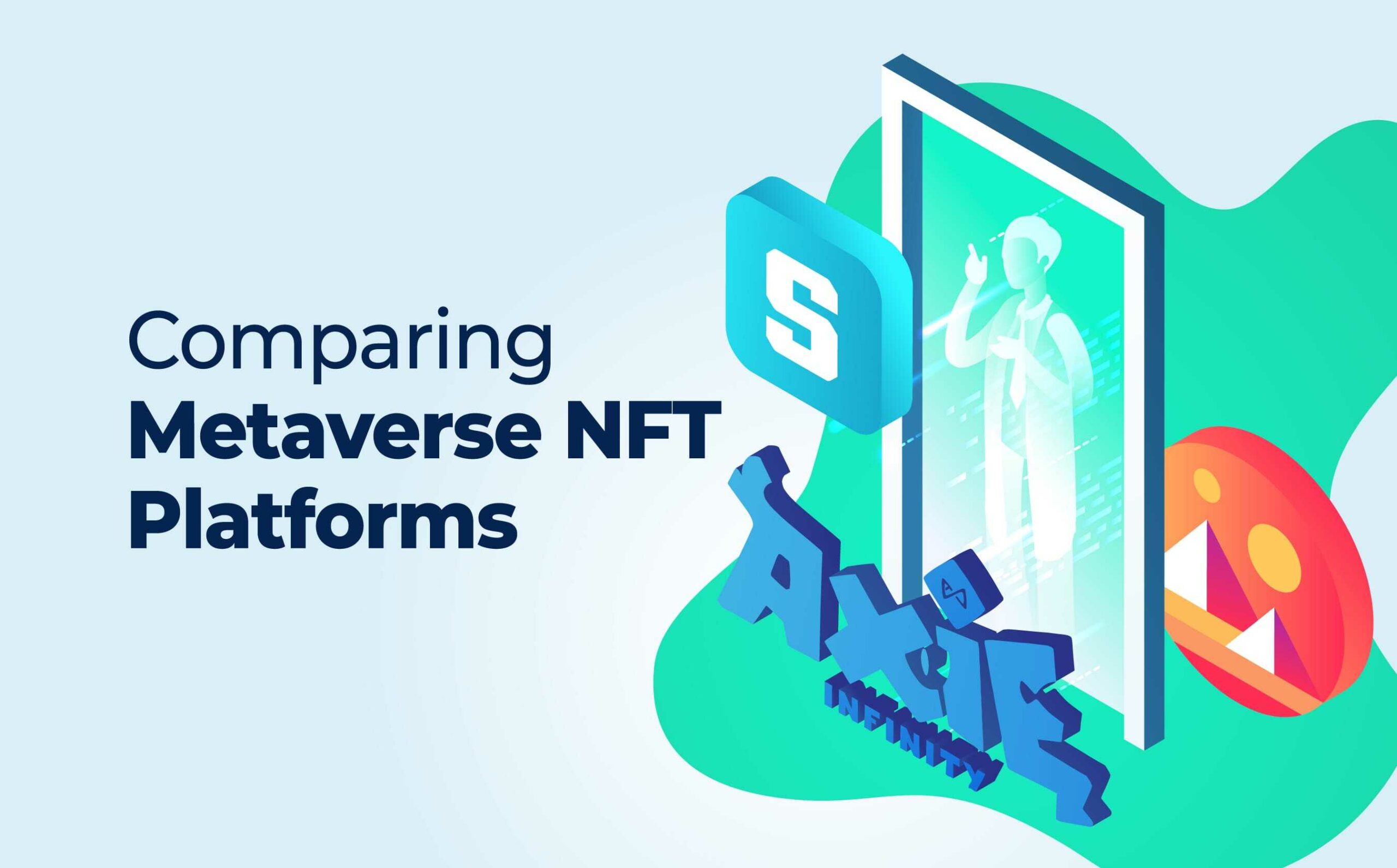
Metaverse NFT platforms could become part of a multi-billion dollar industry based on crypto’s expansion and the migration of online gaming to the blockchain and NFT game industry. Online gaming alone is already a multi-billion dollar industry. So, when we consider NFT gaming and the other sectors that could come along with it to the metaverse, it’s easy to see the potential.
As non-fungible token (NFT) mania continues to gain momentum, it also adds to today’s metaverse conversation. This article will focus on the core components of this new frontier – primarily the different emerging metaverse NFT platforms. But first, let’s dig into what the metaverse is and the framework it will require to succeed.
The Metaverse Emerges – Object Permanence
Items in the metaverse must behave like items in the real world for people to relate to them. In turn, these objects must know about all the others that exist. If objects are to be aware of each other, they must have a single truth source. Likewise, the objects must know this source. So, the metaverse (whatever it is) will require object permanence.

With this starting point, we can create a ledger of the objects in the metaverse along with their shared history of interactions. First, we need to document them into a universal ledger. Next, we can build a digital world around it. That digital world is called the metaverse. But the underlying framework of the metaverse needs to be a universal ledger.
The Universal Ledger of Ethereum
We’ve all experienced the “nation-state” to varying degrees inside our countries of origin. Whether it be a drivers’ license, a social security number, or a business tax ID, the nation-state serializes people and property within its borders for taxation. Nation-states need an orderly way of accounting for taxable resources to maximize revenue for the state.
Ethereum also likes order and serialization. To exist on Ethereum, one needs an Ethereum address. To deploy a token, the token needs a contract address. One’s address must interact with another contract address to buy an NFT. This way, Ethereum can update the ledger.
The main difference between the nation-state is that individuals can choose to opt into Ethereum. They can select their identity and assign numbers to the objects they create. In this way, Ethereum serializes objects into the metaverse. Furthermore, “tokenization” is the process that makes an object known to each other. Thus, Ethereum acts as a universal ledger.
Want more information on Ethereum? Join Moralis Academy and learn all you need to know in the Ethereum 101 course.
Metaverse NFT Platforms and ERC-721 Tokens
The standard ERC-20 tokens on Ethereum are fungible and do nothing for associating an address to an identity. However, ERC-721 tokens are non-fungible tokens (NFTs), and they do everything for that association. NFTs are specific, and they begin the formulation process of identity that resides behind the private keys.

Let’s take the wildly popular “CryptoPunks” collection, for example. If a user holds a CryptoPunk NFT, that person cannot send the CryptoPunk privately to another wallet. Since there is only one, the NFT functions as a chain of identity across all Ethereum addresses. So, in this case, Ethereum is concerned with the object that the address holds rather than the address itself.
The Metaverse and Identity
Ethereum doesn’t care which person you are. But when you purchase an NFT, you are selecting something specific. In this contact with specific NFTs, Ethereum distinguishes these addresses from other addresses in the metaverse. This object, therefore, obtains a traceable path and a unique story.
Therefore, the metaverse offers a significant shift as to how we view identity. Features such as skin color, hair color, height, and gender define identity in the physical world. These are the kinds of features you might see on a person’s driver’s license or other nation-state documents.
On the other hand, a person’s physical features aren’t relevant to Ethereum. Humans can select a digital representation of themselves that is wildly different from their birth characteristics.
Metaverse NFT Platforms and Game Financialization
Now that you know more about what comprises the metaverse, let’s take a look at “GameFi.” In a strictly monetary sense, spending time “gaming” adds up to wasted hours. Building armies, reaching higher levels, and obtaining lands disappear once the player leaves the game’s environment.

However, what if a gamer could keep what they earned? Not only the power to keep items and use them on other platforms, but also to sell, loan, or showcase them to others? This scenario is what GameFi promises.
GameFi resides under a new genre of the digital economy. It continues after the game is turned off, thus blurring the lines between in-game items and real-world assets. GameFi represents a paradigm shift whereby players take ownership (or at least part ownership) of their favorite game(s).
GameFi in the Metaverse
What GameFi does is blend games and finance. Furthermore, it merges fun entertainment and games with the financialization of in-game economies. Blockchain technology enables players to show verifiable ownership of their assets and allows marketplaces for trading in-game items.
On the blockchain, tokens represent game objects. The players can own their weapons, armor, and plots of land in blockchain-based games. So, in these games, players become participants and owners. Games may differ, but the recurring theme is striving to accumulate resources. Playing well allows gamers to earn more in-game assets, fungible tokens, and NFTs.
To sum up, the critical advantages GameFi offers are that players can take their assets to other gaming platforms or trade them on marketplaces.
Metaverse NFT Platforms and Play-to-Earn
GameFi’s play-to-earn (P2E) concept isn’t all that novel, but other aspects are. By combining token incentives and gaming, a myriad of possibilities opens up.

Since game NFTs can integrate into a plethora of different platforms on the blockchain, players can transfer in-game items from one game to another.
Users can take tokenized in-game assets and use them outside the game itself. For example, owners can use NFTs to prove ownership of rare, in-game items. Moreover, everything works together to build out a giant metaverse.
Also, since other desirable NFTs already sell for a fortune, it’s not an exaggeration to suggest that game NFTs could also fetch high prices one day. DeFi lending protocols could post NFTs as collateral and loan them to players looking for in-game assets. In short, the potential for NFTs to serve as financial assets earned through games is an idea yet to be fully explored and tapped. However, it is one worth keeping an eye on.
If you would like to learn how to create an NFT marketplace but are not ready just yet to enroll in Moralis Academy, then check out Moralis’ blog. There, we publish content for programmers so that they can utilize their solid blockchain development skills and create projects such as building cross-chain dApps or developing a decentralized messaging app in five steps.
Metaverse NFT Platforms and Gaming Trends
GameFi continues a long trend as we see the power shifting from game studios to players.
1. Pay-to-Play (P2P)
The first video games began with this revenue model. As such, users had to pay to play a game.
2. Free-to-Play (F2P)
In the late 1990s, F2P games started to spring up. Fans could download a game for free, and if they liked it, they could pay later. Studios profited by means of ad revenue and by selling premium add-ons.
3. Play-to-Earn (P2E)
Back in the 2000s, some F2P games such as Runescape offered marketplaces for in-game items. Players earned “gold” by completing quests and could use the gold to buy things such as armor or weapons. Then, they could later sell these items for money.

During this era, gamers built a digital economy in a niche corner of the internet. But with all the scams afoot, the sector was more like a den of shady characters operating a black market than a healthy ecosystem bustling with entrepreneurs.
Moreover, P2E has matured. This day in age offers a more sophisticated market and more autonomy for the players. Moreover, ownership incentives should help players become more engaged and loyal to their favorite game(s).
GameFi’s Challenges
Players have shown interest in GameFi. But game developers have had to find creative ways to avoid the high network costs of operating on Ethereum. The obvious way around high transaction fees has been to deploy to layer-2 solutions. “Gods Unchained”, for instance, deployed on top of Immutable X, which uses Starkware as its layer-2 solution. Other games have chosen various layer-2 solutions such as “Optimism” or a side-chain like “Ronin” in the case of Axie Infinity. Layer-2 solutions arrived in time to help GameFi companies avoid the crippling problem of high transaction costs.
If you want to understand GameFi, NFTs, and the metaverse, you’ll need a solid foundation. So get started now at Moralis Academy with the Crypto for Beginners course!

Popular Metaverse NFT Platforms
We’ve already covered Immutable X’s God’s Unchained and Axie Infinity in other articles. Therefore, below are some other metaverse NFT platforms with impressive market caps or significant investor or player interest. It’s hard to believe that many have only been around for only a few years.
1. Decentraland
This project got rolling publicity-wise around 2017. The fact that Decentraland is considered one of the “OG” projects testifies to how new this space is.
Decentraland has multiple land parcels that users can purchase with the MANA token. Land on Decentraland is NFT maintained in an Ethereum smart contract. Moreover, with new lands, worlds, galaxies, and universes coming to the metaverse, projects with finite amounts of land will capitalize on the scarcity factor.
Learn more about Decentraland here.

2. The Sandbox
The founders come from the world of iOS and Android app development. Their entry into the space could signal a shift from mobile apps to metaverse gaming. The Sandbox founders understand that industry well, which should be an advantage for them.
With the SAND token, users can buy and sell assets such as virtual lands. The lands available are finite and can be used to create housing, build player experiences, and host games.
Learn more about The Sandbox here.
3. Axie Infinity
Axie Infinity made P2E gaming more popular. They weren’t the first to do it, but Axie Infinity combines P2E with gaming plus NFTs for the total metaverse experience.
Learn more about Axie Infinity here.

4. Cryptovoxels
This virtual world is also on Ethereum. Its simple, old-school interface takes its users back in time, and many people like it that way. Furthermore, “Origin City” is Cryptovoxels‘ hub.
Learn more about Cryptovoxels here.
5. Starlink
The Starlink platform represents the power of one developer – “Woof Decentra”. She’s attempting to build a vast ecosystem where users can buy, sell and trade land, virtual satellites, and spacecraft while exploring the solar system.

6. Decentral.Games
This project is a community-owned casino in the metaverse. Decentral.Games is working hard to create a gambling ecosystem with blackjack, slots, roulette, and poker.
7. RFOX VALT Metaverse
This project brings retail shopping into the metaverse.
8. bit.Country
At “Bit.Country”, users can start a 3D world in the metaverse with NFT games, social tokens, and more.
9. NETVRK
The team at “NETVRK” is trying to take virtual reality mainstream. They are a self-described social VR platform.
The list of metaverse NFT platforms goes on, some of which we’ve already covered in other articles. If you’re interested in more projects, please check out Somnium Space, Illuvium, Splinterlands, StarAtlas, Genshin, Vulcan, CryptoBlades, Chain Games, and Ember Sword.
Metaverse NFT Platforms – Conclusion
Now that we’ve looked at some of the prominent metaverse NFT platforms, we’ve seen a significant portion of what makes up the whole ecosystem. People use the term “metaverse” to describe the vast, disparate virtual worlds floating around in cyberspace, and while we’ve covered many projects, many more are yet to come.
We’re barely in “act one” when it comes to the metaverse. So, we can expect much more migration from traditional industries and new ones yet to be discovered. While big players such as “Meta” (formerly Facebook) and Microsoft appear ready to lay claim to the “metaverse” name for marketing purposes, their versions will likely be caricatures of the real thing.
They’re more apt to create yet another walled garden with sectioned-off silos for big brands to corral new customers. Ethereum, on the other hand, already has the universal ledger and infrastructure in place. It has everything needed to connect all the objects floating around in these digital worlds, galaxies, and universes. Ethereum, DeFi, and NFTs will combine to offer a genuinely open metaverse compared to the contrived, corporate-dominated alternatives.
Are you ready to become a blockchain developer and participate in a red-hot job market? Get started at Moralis Academy today!




